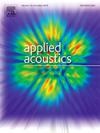Predicting the diffuse sound absorption coefficient of a baffled finite absorber
IF 3.4
2区 物理与天体物理
Q1 ACOUSTICS
引用次数: 0
Abstract
Due to the edge effect, the diffuse sound absorption coefficient of a finite absorber can be quite different from that of the corresponding infinite one. In this paper, a matrix form formula is derived for the diffuse sound absorption coefficient of a baffled finite planar absorber. The diffuse sound field is modeled as the reverberant loading on the absorber, which is shown to be proportional to the time-averaged mean squared pressure in the far field and the imaginary part of the half space Green's function. By employing the direct boundary integral formulation for the scattering problem, the diffuse sound absorption coefficient is obtained as ratio of the mean value of the power dissipated by the absorber to the intensity of the diffuse sound field and the area of the absorber. Sound absorption in non-homogeneous diffuse field is also considered. The proposed method is validated both analytically and experimentally with earlier works.
求助全文
约1分钟内获得全文
求助全文
来源期刊

Applied Acoustics
物理-声学
CiteScore
7.40
自引率
11.80%
发文量
618
审稿时长
7.5 months
期刊介绍:
Since its launch in 1968, Applied Acoustics has been publishing high quality research papers providing state-of-the-art coverage of research findings for engineers and scientists involved in applications of acoustics in the widest sense.
Applied Acoustics looks not only at recent developments in the understanding of acoustics but also at ways of exploiting that understanding. The Journal aims to encourage the exchange of practical experience through publication and in so doing creates a fund of technological information that can be used for solving related problems. The presentation of information in graphical or tabular form is especially encouraged. If a report of a mathematical development is a necessary part of a paper it is important to ensure that it is there only as an integral part of a practical solution to a problem and is supported by data. Applied Acoustics encourages the exchange of practical experience in the following ways: • Complete Papers • Short Technical Notes • Review Articles; and thereby provides a wealth of technological information that can be used to solve related problems.
Manuscripts that address all fields of applications of acoustics ranging from medicine and NDT to the environment and buildings are welcome.
 求助内容:
求助内容: 应助结果提醒方式:
应助结果提醒方式:


